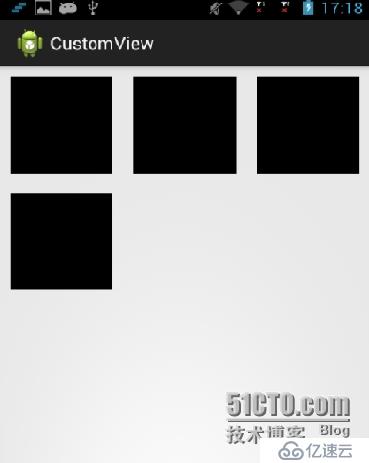您好,登錄后才能下訂單哦!
您好,登錄后才能下訂單哦!
前一篇文章主要講了自定義View為什么要重載onMeasure()方法,那么,自定義ViewGroup又都有哪些方法需要重載或者實現呢 ?
Android開發中,對于自定義View,分為兩種,一種是自定義控件(繼承View類),另一種是自定義布局容器(繼承ViewGroup)。如果是自定義控件,則一般需要重載兩個方法,一個是onMeasure(),用來測量控件尺寸,另一個是onDraw(),用來繪制控件的UI。而自定義布局容器,則一般需要實現/重載三個方法,一個是onMeasure(),也是用來測量尺寸;一個是onLayout(),用來布局子控件;還有一個是dispatchDraw(),用來繪制UI。
本文主要分析自定義ViewGroup的onLayout()方法的實現。
ViewGroup類的onLayout()函數是abstract型,繼承者必須實現,由于ViewGroup的定位就是一個容器,用來盛放子控件的,所以就必須定義要以什么的方式來盛放,比如LinearLayout就是以橫向或者縱向順序存放,而RelativeLayout則以相對位置來擺放子控件,同樣,我們的自定義ViewGroup也必須給出我們期望的布局方式,而這個定義就通過onLayout()函數來實現。
我們通過實現一個水平優先布局的視圖容器來更加深入地了解onLayout()的實現吧,效果如圖所示(黑色方塊為子控件,白色部分為自定義布局容器)。該容器的布局方式是,首先水平方向上擺放子控件,水平方向放不下了,則另起一行繼續水平擺放。

1. 自定義ViewGroup的派生類
第一步,則是自定ViewGroup的派生類,繼承默認的構造函數。
public class CustomViewGroup extends ViewGroup {
public CustomViewGroup(Context context) {
super(context);
}
public CustomViewGroup(Context context, AttributeSet attrs) {
super(context, attrs);
}
public CustomViewGroup(Context context, AttributeSet attrs, intdefStyle) {
super(context, attrs, defStyle);
}
}2. 重載onMeasure()方法
為什么要重載onMeasure()方法這里就不贅述了,上一篇文章已經講過,這里需要注意的是,自定義ViewGroup的onMeasure()方法中,除了計算自身的尺寸外,還需要調用measureChildren()函數來計算子控件的尺寸。
onMeasure()的定義不是本文的討論重點,因此這里我直接使用默認的onMeasure()定義,當然measureChildren()是必須得加的。
@Override
protected void onMeasure(int widthMeasureSpec, int heightMeasureSpec) {
super.onMeasure(widthMeasureSpec, heightMeasureSpec);
measureChildren(widthMeasureSpec, heightMeasureSpec);
}3. 實現onLayout()方法
onLayout()函數的原型如下:
//@param changed 該參數指出當前ViewGroup的尺寸或者位置是否發生了改變 //@param left top right bottom 當前ViewGroup相對于其父控件的坐標位置 protected void onLayout(boolean changed,int left, int top, int right, int bottom);
由于我們希望優先橫向布局子控件,那么,首先,我們知道總寬度是多少,這個值可以通過getMeasuredWidth()來得到,當然子控件的寬度也可以通過子控件對象的getMeasuredWidth()來得到。
這樣,就不復雜了,具體的實現代碼如下所示:
protected void onLayout(boolean changed, int left, int top, int right, int bottom) {
int mViewGroupWidth = getMeasuredWidth(); //當前ViewGroup的總寬度
int mPainterPosX = left; //當前繪圖光標橫坐標位置
int mPainterPosY = top; //當前繪圖光標縱坐標位置
int childCount = getChildCount();
for ( int i = 0; i < childCount; i++ ) {
View childView = getChildAt(i);
int width = childView.getMeasuredWidth();
int height = childView.getMeasuredHeight();
//如果剩余的空間不夠,則移到下一行開始位置
if( mPainterPosX + width > mViewGroupWidth ) {
mPainterPosX = left;
mPainterPosY += height;
}
//執行ChildView的繪制
childView.layout(mPainterPosX,mPainterPosY,mPainterPosX+width, mPainterPosY+height);
//記錄當前已經繪制到的橫坐標位置
mPainterPosX += width;
}
}4. 布局文件測試
下面我們就嘗試寫一個簡單的xml文件,來測試一下我們的自定義ViewGroup,我們把子View的背景顏色都設置為黑色,方便我們辨識。
<com.titcktick.customview.CustomViewGroup xmlns:android="http://schemas.android.com/apk/res/android" xmlns:tools="http://schemas.android.com/tools" android:layout_width="match_parent" android:layout_height="match_parent"> <View android:layout_width="100dp" android:layout_height="100dp" android:layout_margin="10dp" android:background="@android:color/black"/> <View android:layout_width="100dp" android:layout_height="100dp" android:layout_margin="10dp" android:background="@android:color/black"/> <View android:layout_width="100dp" android:layout_height="100dp" android:layout_margin="10dp" android:background="@android:color/black"/> <View android:layout_width="100dp" android:layout_height="100dp" android:layout_margin="10dp" android:background="@android:color/black"/> </com.titcktick.customview.CustomViewGroup>
5. 添加layout_margin
為了讓核心邏輯更加清晰,上面的onLayout()實現我隱去了margin的計算,這樣就會導致子控件的layout_margin不起效果,所以上述效果是子控件一個個緊挨著排列,中間沒有空隙。那么,下面我們來研究下如何添加margin效果。
其實,如果要自定義ViewGroup支持子控件的layout_margin參數,則自定義的ViewGroup類必須重載generateLayoutParams()函數,并且在該函數中返回一個ViewGroup.MarginLayoutParams派生類對象,這樣才能使用margin參數。
ViewGroup.MarginLayoutParams的定義關鍵部分如下,它記錄了子控件的layout_margin值:
public static class MarginLayoutParams extends ViewGroup.LayoutParams {
public int leftMargin;
public int topMargin;
public int rightMargin;
public int bottomMargin;
}你可以跟蹤源碼看看,其實XML文件中View的layout_xxx參數都是被傳遞到了各種自定義ViewGroup.LayoutParams派生類對象中。例如LinearLayout的LayoutParams定義的關鍵部分如下:
public class LinearLayout extends ViewGroup {
public static class LayoutParams extends ViewGroup.MarginLayoutParams {
public float weight;
public int gravity = -1;
public LayoutParams(Context c, AttributeSet attrs) {
super(c, attrs);
TypedArray a = c.obtainStyledAttributes(attrs, com.android.internal.R.styleable.LinearLayout_Layout);
weight = a.getFloat(com.android.internal.R.styleable.LinearLayout_Layout_layout_weight, 0);
gravity = a.getInt(com.android.internal.R.styleable.LinearLayout_Layout_layout_gravity, -1);
a.recycle();
}
}
@Override
public LayoutParams generateLayoutParams(AttributeSet attrs) {
return new LinearLayout.LayoutParams(getContext(), attrs);
}
}這樣你大概就可以理解為什么LinearLayout的子控件支持weight和gravity的設置了吧,當然我們也可以這樣自定義一些屬于我們ViewGroup特有的params,這里就不詳細討論了,我們只繼承MarginLayoutParams來獲取子控件的margin值。
public class CustomViewGroup extends ViewGroup {
public static class LayoutParams extends ViewGroup.MarginLayoutParams {
public LayoutParams(Context c, AttributeSet attrs) {
super(c, attrs);
}
}
@Override
public LayoutParams generateLayoutParams(AttributeSet attrs) {
return new CustomViewGroup.LayoutParams(getContext(), attrs);
}
}這樣修改之后,我們就可以在onLayout()函數中獲取子控件的layout_margin值了,添加了layout_margin的onLayout()函數實現如下所示:
@Override
protected void onLayout(boolean changed, int left, int top, int right, int bottom) {
int mViewGroupWidth = getMeasuredWidth(); //當前ViewGroup的總寬度
int mViewGroupHeight = getMeasuredHeight(); //當前ViewGroup的總高度
int mPainterPosX = left; //當前繪圖光標橫坐標位置
int mPainterPosY = top; //當前繪圖光標縱坐標位置
int childCount = getChildCount();
for ( int i = 0; i < childCount; i++ ) {
View childView = getChildAt(i);
int width = childView.getMeasuredWidth();
int height = childView.getMeasuredHeight();
CustomViewGroup.LayoutParams margins = (CustomViewGroup.LayoutParams)(childView.getLayoutParams());
//ChildView占用的width = width+leftMargin+rightMargin
//ChildView占用的height = height+topMargin+bottomMargin
//如果剩余的空間不夠,則移到下一行開始位置
if( mPainterPosX + width + margins.leftMargin + margins.rightMargin > mViewGroupWidth ) {
mPainterPosX = left;
mPainterPosY += height + margins.topMargin + margins.bottomMargin;
}
//執行ChildView的繪制
childView.layout(mPainterPosX+margins.leftMargin, mPainterPosY+margins.topMargin,mPainterPosX+margins.leftMargin+width, mPainterPosY+margins.topMargin+height);
mPainterPosX += width + margins.leftMargin + margins.rightMargin;
}
}6. 總結
費了好大勁,終于算是把自定義ViewGroup的onLayout()相關知識點講清楚了,如果有任何疑問歡迎留言或者來信lujun.hust@gmail.com交流,,或者關注我的新浪微博 @盧_俊 獲取最新的文章和資訊。
免責聲明:本站發布的內容(圖片、視頻和文字)以原創、轉載和分享為主,文章觀點不代表本網站立場,如果涉及侵權請聯系站長郵箱:is@yisu.com進行舉報,并提供相關證據,一經查實,將立刻刪除涉嫌侵權內容。